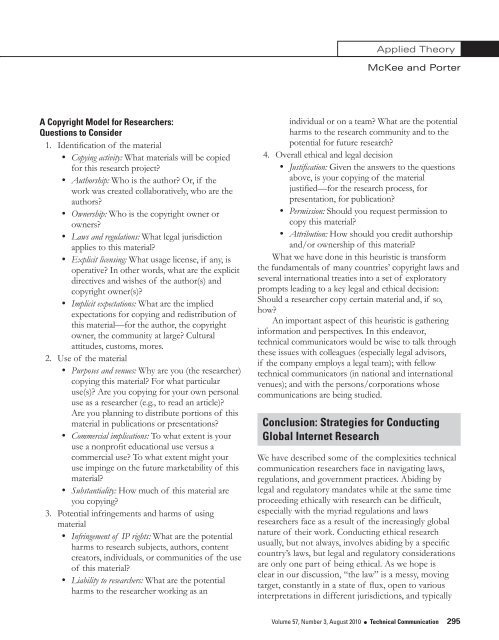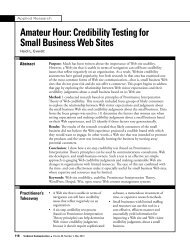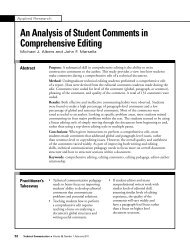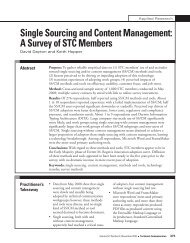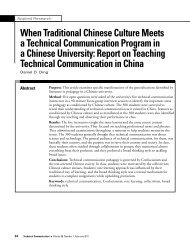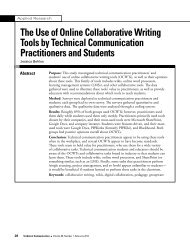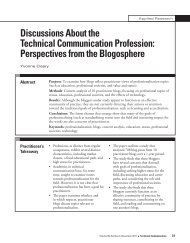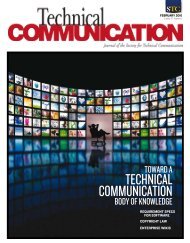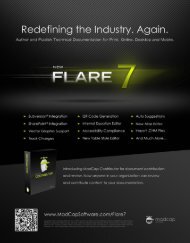Applied TheoryConducting Global Internet Researchhow users and technical developers communicate witheach other in these forums.We start our research project by collecting samplesand reviewing different models of user help forums.One site we study is Adobe Support Forums (http://forums.adobe.com/index.jspa), in particular the AdobeDreamweaver forums. For an example of the type ofdiscussion we study, see the thread on “I need differenttype size to appear on the same line” (http://forums.adobe.com/thread/520240?tstart=0).Our main research purpose for examining these sitesis to determine how quickly and how accurately usersrequesting assistance received helpful answers to theirquestions. In short, do these online user forums actuallywork? And which models for online user help seem towork best? The goal for our research is to develop abetter understanding of how social networking sites canprovide user help and to recommend a model for sucha site for our own company. At first our research willbe presented at company meetings and in short internalreports, so the copying we do for this research will not bedistributed publicly. But eventually we plan to distributecopied material more widely in conference presentationsand perhaps even in research publications, because thecompany wishes to establish itself as a knowledgeableleader in the area of social networking and user help.Can we, ethically and legally, use information fromthese forums? We have to begin by defining “use.”If we mean read-only (even if we are, technicallyspeaking, downloading a copy of the forum to ourlocal machine), then we are not reproducing orredistributing the information in any way that wouldcause a problem for intellectual property. Our “copying”is simply downloading for personal use, information,and knowledge—and such a use of publicly availableinformation is highly protected under fair use/fairdealing provisions in all jurisdictions that we can imagine.If, however, our use of the information involvesdownloading and redistribution of the material to otherreaders for other purposes, that act of distributing copiespushes us into another level of consideration:• What type of information are we copying (imagesvs. text)?• What quantity of material are we copying (genericuse vs. specific quoting vs. graphical capture)?• For what purposes are we reproducing this material(commercial vs. noncommercial)?• How are we distributing this copied material (howwidely and by what means)?The information on these user forums is publiclyavailable on the Web, meaning that, even though we havenot registered as Adobe forum users, we can access thispage. But on the forum page itself, we do not see anystatement about use, so we turn to the Terms of Useagreement.Reading far into this agreement, we find thisprohibition:You are agreeing NOT to reproduce, sell,trade, resell or exploit for any commercialpurpose, any portion of the Site, theServices or any Materials, use of anyService or Materials, or access to anyService or Materials. (Section 6, UserConduct, Subsection #19)By quoting from an individual user’s post in thisforum in the work for hire we are producing for ourcompany, are we (a) violating that person’s copyright or(b) violating Adobe’s copyright? If the individuals haveposted from countries around the world, as many in theAdobe help forums do, which countries’ copyright lawapplies? The law of the individual post writer’s country?U.S. law, because Adobe is a U.S. corporation? The lawof the country where our corporation is based? The lawof the country where we seek to present and publish ourwork?As we hope is clear in this brief example ofintellectual property, researchers face complicated andconstantly changing laws, ethics, customs, internationalstandards, and political stances toward the use ofinformation. Somehow, researchers have to make someprocedural sense out of this complexity—or at leastenough sense to make prudent legal decisions abouttheir research. So, rather than supplying specific answersto the questions in our hypothetical example (answersthat would vary depending on the material being copied,the context of use, and the countries and technologiesinvolved), we will provide a heuristic for researchers toreflect on the intellectual property implications of theircopying activity.294 Technical Communication l Volume 57, Number 3, August 2010
Applied TheoryMcKee and PorterA Copyright Model for Researchers:Questions to Consider1. Identification of the material• Copying activity: What materials will be copiedfor this research project?• Authorship: Who is the author? Or, if thework was created collaboratively, who are theauthors?• Ownership: Who is the copyright owner orowners?• Laws and regulations: What legal jurisdictionapplies to this material?• Explicit licensing: What usage license, if any, isoperative? In other words, what are the explicitdirectives and wishes of the author(s) andcopyright owner(s)?• Implicit expectations: What are the impliedexpectations for copying and redistribution ofthis material—for the author, the copyrightowner, the community at large? Culturalattitudes, customs, mores.2. Use of the material• Purposes and venues: Why are you (the researcher)copying this material? For what particularuse(s)? Are you copying for your own personaluse as a researcher (e.g., to read an article)?Are you planning to distribute portions of thismaterial in publications or presentations?• Commercial implications: To what extent is youruse a nonprofit educational use versus acommercial use? To what extent might youruse impinge on the future marketability of thismaterial?• Substantiality: How much of this material areyou copying?3. Potential infringements and harms of usingmaterial• Infringement of IP rights: What are the potentialharms to research subjects, authors, contentcreators, individuals, or communities of the useof this material?• Liability to researchers: What are the potentialharms to the researcher working as anindividual or on a team? What are the potentialharms to the research community and to thepotential for future research?4. Overall ethical and legal decision• Justification: Given the answers to the questionsabove, is your copying of the materialjustified—for the research process, forpresentation, for publication?• Permission: Should you request permission tocopy this material?• Attribution: How should you credit authorshipand/or ownership of this material?What we have done in this heuristic is transformthe fundamentals of many countries’ copyright laws andseveral international treaties into a set of exploratoryprompts leading to a key legal and ethical decision:Should a researcher copy certain material and, if so,how?An important aspect of this heuristic is gatheringinformation and perspectives. In this endeavor,technical communicators would be wise to talk throughthese issues with colleagues (especially legal advisors,if the company employs a legal team); with fellowtechnical communicators (in national and internationalvenues); and with the persons/corporations whosecommunications are being studied.Conclusion: Strategies for ConductingGlobal Internet ResearchWe have described some of the complexities technicalcommunication researchers face in navigating laws,regulations, and government practices. Abiding bylegal and regulatory mandates while at the same timeproceeding ethically with research can be difficult,especially with the myriad regulations and lawsresearchers face as a result of the increasingly globalnature of their work. Conducting ethical researchusually, but not always, involves abiding by a specificcountry’s laws, but legal and regulatory considerationsare only one part of being ethical. As we hope isclear in our discussion, “the law” is a messy, movingtarget, constantly in a state of flux, open to variousinterpretations in different jurisdictions, and typicallyVolume 57, Number 3, August 2010 l Technical Communication 295
- Page 1 and 2: AUGUST 2010Volume 57 Number 3SPECIA
- Page 3 and 4: PresidentMichael A. HughesVice Pres
- Page 5 and 6: VoLuME 57, NuMBER 3AUGUST 2010ISSN
- Page 7 and 8: Guest EditorialKirk St.Amant and Ma
- Page 9 and 10: Applied ResearchTechnical Communica
- Page 11 and 12: Applied ResearchNicole St. Germaine
- Page 13 and 14: Applied ResearchNicole St. Germaine
- Page 15 and 16: Applied ResearchNicole St. Germaine
- Page 17 and 18: Applied ResearchNicole St. Germaine
- Page 19 and 20: Applied ResearchNicole St. Germaine
- Page 21 and 22: Applied ResearchNicole St. Germaine
- Page 23 and 24: Applied ResearchNicole St. Germaine
- Page 25 and 26: Applied TheoryTatiana BatovaIntrodu
- Page 27 and 28: Applied TheoryTatiana BatovaMoreno,
- Page 29 and 30: Applied TheoryTatiana BatovaThe Uni
- Page 31 and 32: Applied TheoryTatiana Batovadoctors
- Page 33 and 34: Applied TheoryTatiana BatovaTo addr
- Page 35 and 36: Applied TheoryTatiana Batovathe loc
- Page 37 and 38: Applied TheoryTatiana BatovaJohnson
- Page 39 and 40: Applied TheoryTatiana BatovaInterna
- Page 41 and 42: Applied TheoryMcKee and PorterIntro
- Page 43 and 44: Applied TheoryMcKee and PorterFor e
- Page 45 and 46: Applied TheoryMcKee and Porterpubli
- Page 47 and 48: Applied TheoryMcKee and PorterBecau
- Page 49 and 50: Applied TheoryMcKee and Porterof th
- Page 51: Applied TheoryMcKee and Porterwith
- Page 55 and 56: Applied TheoryMcKee and PorterConte
- Page 57 and 58: Applied TheoryMcKee and PorterWalto
- Page 59 and 60: Applied ResearchLiza PottsIntroduct
- Page 61 and 62: Applied ResearchLiza Pottsdoes not
- Page 63 and 64: Applied ResearchLiza PottsUser’s
- Page 65 and 66: Applied ResearchLiza Pottsactors, t
- Page 67 and 68: Applied ResearchLiza PottsDRM has a
- Page 69 and 70: Applied ResearchLiza Pottsmake bett
- Page 71 and 72: Applied ResearchLiza PottsOne viewe
- Page 73 and 74: Applied ResearchLiza Pottsinvolved
- Page 75 and 76: Applied ResearchLiza PottsHayhoe, G
- Page 77 and 78: Applied ResearchInternational Fair
- Page 79 and 80: Applied ResearchTyAnna K. Herringto
- Page 81 and 82: Applied ResearchTyAnna K. Herringto
- Page 83 and 84: Applied ResearchTyAnna K. Herringto
- Page 85 and 86: Applied ResearchTyAnna K. Herringto
- Page 87 and 88: Applied ResearchTyAnna K. Herringto
- Page 89 and 90: Book ReviewsWriting Successful Scie
- Page 91 and 92: Book ReviewsThe Process: Business P
- Page 93 and 94: Book ReviewsHCI Beyond the GUI: Des
- Page 95 and 96: Book ReviewsOrigins of the Specious
- Page 97 and 98: Book Reviewsgenre, and process, top
- Page 99 and 100: Book ReviewsPart One goes from the
- Page 101 and 102: Book Reviewsrather than writers, an
- Page 103 and 104:
Book ReviewsHow to Write Fast Under
- Page 105 and 106:
Book Reviewsmanagement system (CMS)
- Page 107 and 108:
Book Reviewsnearly strangled when h
- Page 109 and 110:
Book Reviewsinteractive TV model)
- Page 111 and 112:
Book ReviewsOtherwise, Beech shows
- Page 113 and 114:
Book Reviewssuch as blog, I found m
- Page 115 and 116:
Book Reviewsemployees and effective
- Page 117 and 118:
Recent & RelevantSherry Southard, E
- Page 119 and 120:
Recent & RelevantRecent & RelevantC
- Page 121 and 122:
Recent & RelevantRecent & RelevantE
- Page 123 and 124:
Recent & Relevantworking in a langu
- Page 125 and 126:
Recent & RelevantWhat’s the big d
- Page 127 and 128:
Recent & RelevantScientific Writing
- Page 129 and 130:
Recent & Relevantapplicability. Man
- Page 131:
Did You Missthe Summit?Don’t miss


